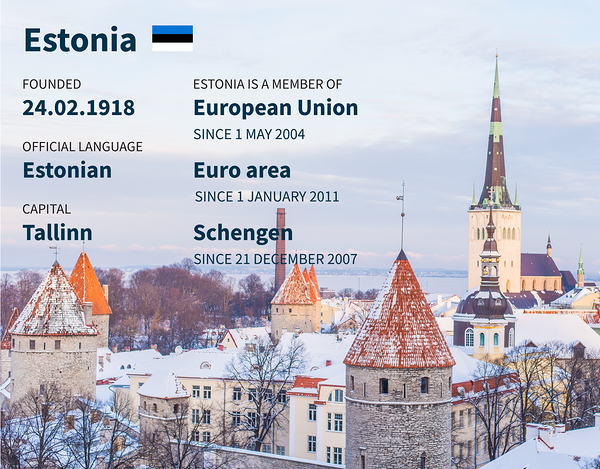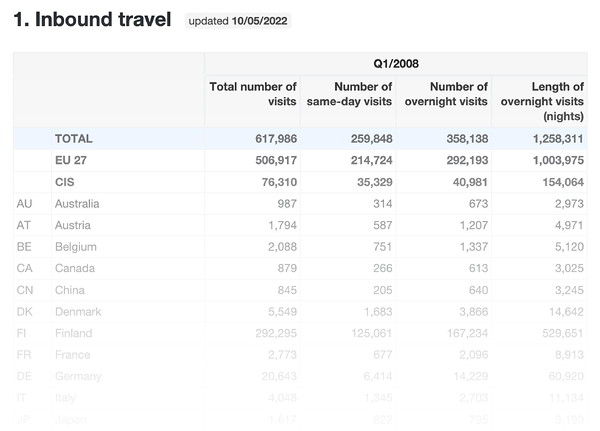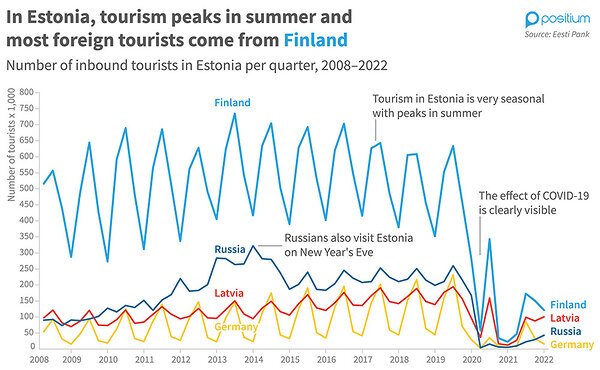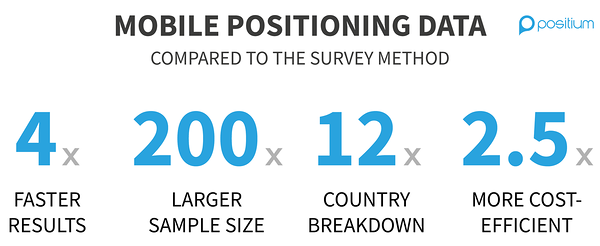In 2008, due to the financial crisis, the Estonian government was forced to make drastic budget cuts. One of the areas affected was the production of official statistics. The quarterly cross-border surveys that the country relied on at the time for estimating international arrivals were put on hold.
Additionally, as Estonia had just joined the Schengen Area, there was no overview of border crossings at the European Union’s internal borders.
One of the institutions affected by these changes was Eesti Pank, the central bank of Estonia, which is responsible for producing external sector statistics, among other official data.
The central bank relied on the traveller statistics series to calculate the balance of payments of the country. This was a crucial statistic since, at the time (2007), tourism accounted for about 8% of the Estonian GDP.
Since there was a demand for a high-quality and efficient data source for tourism statistics, at a reasonable cost, Eesti Pank acted quickly. They began to explore options for alternative data sources to fulfil their obligation of producing a time series of inbound and outbound travel statistics as part of their calculation for the balance of payments.
Today, Eesti Pank has been producing the monthly international travel statistics series uninterrupted for 14 years, using mobile positioning data (MPD) as the main data source for official travel statistics. This case study looks at how the decision to use MPD was taken and what advantages it has had.
Solution: Mobile Positioning Data
After analysing the pros and cons of different options available to them, Eesti Pank opted for MPD as the simplest, fastest and relatively low-cost statistics instrument to use.
Jaanus Kroon, Head of the Statistics Department at Eesti Pank, said the following during a recent webinar presentation organised by the World Tourism Organization (UNWTO): ‘We decided to use mobile positioning data as a key data source. You can say that we made a little revolution, at least that’s what we were thinking, since already at the time everyone had a cell phone.’
In 2009, even the concept of big data and its use for decision-making or the production of official statistics was fairly new. Actually, no one had used the term ‘big data’ yet.
‘The availability of a potential partner was the other side of the decision. Positium already had some experience in using MPD and geographical information in urban planning, human geography, and data science, and we had had many contracts already through procurements. We started to work together to create the methodology for inbound and outbound travel statistics in 2008 and 2009. We have been working with them ever since,’ Kroon added.
In cooperation with Positium, Eesti Pank was able to secure a continuous production of tourism statistics using data exchange with the biggest mobile network operator (MNO) in the country at that time. After the adoption of GDPR in 2018, the central bank has been relying on the Estonian laws that allow the producers of official statistics to use any relevant public or private data sources for the production of official statistics.
‘[More than] ten years ago people mostly shrugged at our presentations on mobile positioning. Today, however, big data is a prospect and challenge for nearly all statistical organisations. And we have the honour of being one of the first ones in this field,’ Kroon commented a couple of years back in a previous article.
Building the Methodology and Models
For now, there are two countries in the world using MPD as their main source for official statistics in tourism, the other one being Indonesia. Positium is working with both countries to process MPD data into official tourism statistics on a regular basis.
Once MPD was chosen by Eesti Pank as the main data source for tourism statistics, the relevant methodology and models were created together with Positium and researchers from the Mobility Lab at the University of Tartu, following different quality frameworks, including those proposed by the United Nations, European Union (EU), International Monetary Fund (IMF), and other international organisations. At the same time, privacy requirements set by the EU were followed as well
Kroon said that one of the challenges is that there is no universal methodology for producing tourism statistics with MPD, and countries need to constantly work on fine-tuning the methodology, and there are always different use cases that need to be identified.
To overcome this challenge, Eesti Pank is collaborating with Positium on an ongoing basis, and works together with the company on improving the methodology and models when needed, since the economic, social environment as well as mobile operator networks are always changing and evolving.
Positium also conducts quality assurance (QA) through different stages of statistical production that have been developed through two decades of research and development that the company has led in the field of MPD.
How the Collaboration Between Eesti Pank and Positium Works
Eesti Pank is responsible for the monthly collection of MNO data. Positium is responsible for data processing and analysis using Positium Data Mediator (PDM).
The central bank conducts data validation on Positium’s output with different reference data they have at hand. They also conduct analyses and dissemination of the international travel statistics series to the public through their website.
The institution uses the statistics on inbound and outbound travels, as well as other sources of information to complete the estimation of the balance of payments. Eesti Pank validates the MPD data using information they gather from credit and debit card payments, for example. Other data sources used for validation purposes include airport statistics, household surveys for inbound travel, as well as accommodation statistics.
Border Crossing Statistics
This all means that Eesti Pank has been producing an uninterrupted time series of travel statistics that goes back to 2008, even in difficult situations such as the COVID-19 pandemic.
Mobile positioning data has allowed Eesti Pank to produce tourism statistics on a regular basis with a data sample 200 times the size of previous quarterly surveys, at twice the speed, with a consistent data output, in a cost-effective way.
‘We produce the statistical series every month, but disseminate data on a quarterly basis. The relevant statistical press release is published together with the statistics. Data is consistent, we always know what we get. Mobile phone data has a remarkably high level of completeness and coverage for travel and border crossing statistics,’ explained Kroon.
Kroon added: ‘Almost 15 years of working with MPD gives us a great data series, economic crises are always a possibility but despite them we have still been able to publish the data series.’
Would you be interested in learning more about mobile big data and Positium? Let's talk about what mobile big data can do to help your organisation make decisions based on population mobility.
.png)



